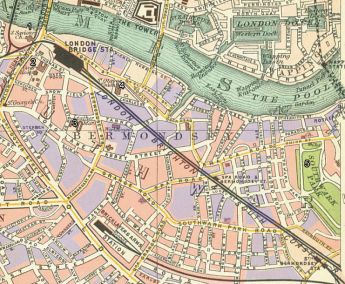VicLondon-Bermondsey
Bermondsey, Southwark
|
District Traits
|
| Interactive: Access x, Information x, Prestige x Reactive: Safety x, Awareness x, Stability x |
Notable Locations
|
| Business: Leather Market & Hide, Wool and Leather Exchange (3) Churches: St. Saviour & St. Marie Overie Cathedral (1) Civic: St. Olave's Union Workhouse (4) Medical: Guy's Hospital (2) Parks: Southwark Park (5) |
Class: Primarily Lower Class and Criminal, with a sprinkling of Middle Class.
Part of Southwark proper, Bermondsey is the district east of Lambeth and centred on the gargantuan London Bridge Station and the bridges into the City. Southwark, London, and Tower bridges feed travellers back and forth. London Bridge Station joins the metropolitan area to the southern coast via the London, Brighton, and South Coast Railway, which cuts straight through Bermondsey. The area is generally poor and working-class, but shops, public houses, and wealthier establishments line High Street Borough, Great Dover Street, and the ring road that connects St. Georges Circle in Lambeth via New Kent Road to Bermondsey North Road to Bermondsey Street with London Bridge Station.
Buildings
Like Lambeth or Whitechapel, much of the area is impoverished, with old houses; some of the oldest buildings in the city once crowded here in the middle of the century, but by 1880, they are swept away in favour of the townhouse and tenement. The people living and working in Bermondsey are often too poor to reside on their own, so many of these tenements would have multiple families living in a tenement house to save money.
This region is filled with row homes, tenement buildings, and sloppily constructed stores and warehouses. The streets are small, busy, and like Whitechapel, very poor. The workers here live in squalor, tucking in a warren of tight low streets that fill the countryside between Walworth in and the river.
Industry
Transportation is a major source of employment here; the railways, the trams and buses, and cartage all run through Bermondsey, bringing goods from the docks in Rotherhithe to the London markets. The river is also a major source of transport, and barges, punt, and various steamers pack the small piers that line the Thames on the Bermondsey and City sides of the water.
Transportation is not the only industry, of course. On Tanner Street, there is the leather market, a giant roofed building where leather goods are sold to businesses. Here the tanners work with hides, thinning, curing, and cutting them for sale. The place reeks of blood, rotting fat, and the chemicals used to tan the hides (often involving urea). It’s a quiet place and the people here have back-breaking jobs that make them sickly. There is a workhouse not far away where the inmates are involved in piecework contracted by local businesses. These contracts are with the house, not the people, so to gain the work one must be an inmate and remain one.
Over on Tolley Street, near the train station, is St. Olaves Union, another charitable house that attempts to find work, and provides a cheap meal, for the workers in the area. Much of Bermondsey has grown up in the last couple of decades, filling in the space between Southwark Park and Old Kent Road, south of Jamaica and Spa Road.
Notable Locations
St. Saviour & St. Marie Overie Cathedral (1)
St. Saviour's, Southwark-, within a few minutes' walk of London Bridge Station, is one of the finest parish churches in the kingdom. Before the Reformation it was known as the Priory Church of St. Mary Overy. The tower, 35 feet square and 150 feet high, is a very solid structure. In 1840 the nave was rebuilt, but in so wretched a fashion that it had to be replaced by another, from the designs of Sir Arthur Blomfield, who undertook a thorough restoration of the fabric, with a view to St. Saviour's becoming a cathedral for South London. The poet John Gower is buried in the south transept, and in the church also lie Edmund Shakespeare, a brother of the poet, Philip Massinger, John Fletcher, and other dramatists and actors who were connected with the old Bankside theatres.
Guy's Hospital (2)
This famous institution was founded by Thomas Guy, a bookseller, who made an immense fortune either by trading in Bibles or by speculating in South Sea stock. The Hospital, which is situated in Southwark, a short distance from London Bridge, was built in the years 1722-25, but considerable additions to it have since been made. Our picture shows the front of the building, with one of the wings in the courtyard is a bronze statue of the pious founder, who did not live to see the Hospital occupied. Guy's has on the average 411 beds occupied every day, but is able to accommodate 500 patients, and in the course of the year some 5,000 in-patients and 70,000 out-patients are treated. The yearly income is about £20,000; and there is a flourishing medical school.
Leather Market & Hide, Wool, and Leather Exchange (3)
A massive market where the goods from the surrounding tanneries are sold in large mercantile bulk. The Exchange also features a gentlemen's club whose membership consists of many of the captains of industry associated with these goods.
St. Olave's Union Workhouse (4)
One of the larger workshouses in Bermondsey, whose residents by and large survive on work from the tanneries in the area.
Southwark Park (3)
Southwark Park has been formed within the last ten years in the dreary district beyond the Bermondsey tan-yards.
